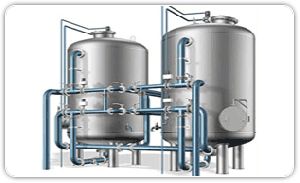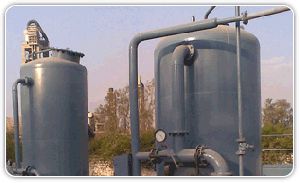
Ultra Filtration Plant
Ultra filtration is a method of removing very small particles from liquid. A membrane used with this method usually has pores that are 0.01 to 0.001 microns in size. This is small enough to remove most bacteria, viruses, high molecular weight substances, and polymer-type molecules. During ultra filtration the flow of liquid gets split into two streams, which is known as cross-flow separation. One stream goes through the porous membrane and is then called permeate, and the other is concentrated in the particles and other matter that have been unable to penetrate the membrane.The process is commonly used for treating drinking water in compliance with strict standards. Many organisms have become resistant to other methods of disinfecting water, but an ultra filtration system removes pathogens by moving water through a membrane, physically removing each organism. The membranes themselves are often formed into small, hollow fibers that are less than a millimeter (about 0.04 inches) in diameter, which are bundled by the thousands in a filter housing. Modules that contain the membranes come in a variety of configurations, including spiral-wound, plate-and-frame, and tubular. The type and concentration of material that needs to be removed helps determine what kind of configuration is used. Ultra filteration is low pressure crossflow membrane process for separating selective molecular weight species from a feed system. The separation is based on selective MWCO (Molecular weight cut-off) Water, Salts and Low molecular weight species selectively pass through the membrane for discharge, reuse or further treatment. Ultrafilteration selectively removes Macromolecules Suspended Solids Turbidity Organics Bacteria Oil and Grease Surfactants Pigments Metal Hydroxides
...more
Sand Filter

Reverse Osmosis Plant
Reverse osmosis (RO) is a filtration method that removes many types of large molecules and ions from solutions by applying pressure to the solution when it is on one side of a selective membrane. The result is that the solute is retained on the pressurized side of the membrane and the pure solvent is allowed to pass to the other side. To be "selective," this membrane should not allow large molecules or ions through the pores (holes), but should allow smaller components of the solution (such as the solvent) to pass freely.In the normal osmosis process the solvent naturally moves from an area of low solute concentration, through a membrane, to an area of high solute concentration. The movement of a pure solvent to equalize solute concentrations on each side of a membrane generates a pressure and this is the "osmotic pressure." Applying an external pressure to reverse the natural flow of pure solvent, thus, is reverse osmosis. The process is similar to membrane filtration. However, there are key differences between reverse osmosis and filtration. The predominant removal mechanism in membrane filtration is straining, or size exclusion, so the process can theoretically achieve perfect exclusion of particles regardless of operational parameters such as influent pressure and concentration. Reverse osmosis, however, involves a diffusive mechanism so that separation efficiency is dependent on solute concentration, pressure, and water flux rate. Reverse osmosis is most commonly known for its use in drinking water purification from seawater, removing the salt and other substances from the water molecules. Advantages of RO Operating cost less than DM plant for TDS higher than 600ppm. Ease of operation Variation in TDS does not significantly alter performance of RO Better purification In addition to dissolved salts, RO removes colloids, organics and bacteria Varied applications RO can be used to recycle and reuse treated waste water. Superior Performance Variation in TDS does not significantly after performance of Reverse Osmosis Better Purification Modular in Construction Expand Capacity at Minimunm Cost In addition to dissolved salts, RO Remove Colloids, Organics and Bacteria RO can be used to recycle and reuse treated waste water Applications Reduction in Total Dissolved Solids (TDS) Recovery of water for reuse from Cooling Tower blowdown Boiler blowdown Treated Effluents (Industrial/Sewage) Retrofitting for performance enhancement of existing DM plant Recycle of treated waste water Special Features - Product flow rate 1.2 - 60 m3/h. - Salt rejection ranges from 90 - 98% depending upon feed water composition. - Product recovery ranges from 50 - 80% based on feed water composition.·- Electrical 415 V, 3 ph, 50 Hz. - Concentrate discharge directed to drain at 'O' psi. - Possible to hook up sophisticated instruments and controls Advantages - Modular design - capacity can be increased to suit requirements. - Fully assembled skid, tested prior to shipment, ease of installation and beneficial use. - Non-corrosive low pressure piping – virtually maintenance free. - Low on energy consumption. - User friendly unit - does not require continuous monitoring. Applications - Ultra pure water for electronic industries - Ultrapure water for pharmaceutical industries - Process water for manufacturing plants - Boiler feed water - Beverage and food processing industry - Drinking water - Waste water- Bio-technology - Mineral water Specifications - Poly propylene cartridge housing pre-filter. - FRP pressure vessels. - Spiral wound membrane elements of polyamide type. - 16 stainless steel multistage pump. - TEFC pump motor. - 316 stainless steel high pressure piping - Low feed pressure switch for pump protection. - High feed pressure switch for membrane & pump protection. - Motor starter with disconnect switch. - Motor contactor with thermal overload protection.- Sample valves for feed, product and concentrate. - Concentrate check valve. - Product check valve. - Automatic feed shut-off valve. - Cleaning connections. - Full control panel instrumentation. - Pump discharge pressure indicator. - Feed and concentrate pressure indicator. - Product and concentrate flow meters. - Conductivity meter. - Power on light. - Fault alarm. - Post shutdown system flush.
...more
pumping system
Pumps come in a variety of sizes for a wide range of applications. They can be classified according to their basic operating principle as dynamic or displacement pumps. Dynamic pumps can be sub-classified as centrifugal and special effect pumps. Displacement pumps can be sub-classified as rotary or reciprocating pumps. In principle, any liquid can be handled by any of the pump designs. Where different pump designs could be used, the centrifugal pump is generally the most economical followed by rotary and reciprocating pumps. Although, positive displacement pumps are generally more efficient than centrifugal pumps, the benefit of higher efficiency tends to be offset by increased maintenance costs. Since, worldwide, centrifugal pumps account for the majority of electricity used by pumps, the focus of this chapter is on centrifugal pump.Centrifugal PumpsA centrifugal pump is of a very simple design. The two main parts of the pump are the impeller and the diffuser. Impeller, which is the only moving part, is attached to a shaft and driven by a motor. Impellers are generally made of bronze, polycarbonate, cast iron, stainless steel as well as other materials. The diffuser (also called as volute) houses the impeller and captures and directs the water off the impeller.Water enters the center (eye) of the impeller and exits the impeller with the help of centrifugal force. As water leaves the eye of the impeller a low-pressure area is created, causing more water to flow into the eye. Atmospheric pressure and centrifugal force cause this to happen. Velocity is developed as the water flows through the impeller spinning at high speed. The water velocity is collected by the diffuser and converted to pressure by specially designed passageways that direct the flow to the discharge of the pump, or to the next impeller should the pump have a multi-stage configuration. The pressure (head) that a pump will develop is in direct relationship to the impeller diameter, the number of impellers, the size of impeller eye, and shaft speed. Capacity is determined by the exit width of the impeller. The head and capacity are the main factors, which affect the horsepower size of the motor to be used. The more the quantity of water to be pumped, the more energy is required.
...more
Water Mineralization Plant
An ion-exchange resin or ion-exchange polymer is an insoluble matrix (or support structure) normally in the form of small (1–2 mm diameter) beads, usually white or yellowish, fabricated from an organic polymer substrate. The material has highly developed structure of pores on the surface of which are sites with easily trapped and released ions. The trapping of ions takes place only with simultaneous releasing of other ions; thus the process is called ion-exchange. There are multiple different types of ion-exchange resin which are fabricated to selectively prefer one or several different types of ions. Ion exchange resin beadsIon-exchange resins are widely used in different separation, purification, and decontamination processes. The most common examples are water softening and water purification. In many cases ion-exchange resins were introduced in such processes as a more flexible alternative to the use of natural or artificial zeolites.Most typical ion-exchange resins are based on cross linked polystyrene. The required active groups can be introduced after polymerization, or substituted monomers can be used. For example, the cross linking is often achieved by adding 0.5-25% of divinylbenzene to styrene at the polymerization process. Non-cross linked polymers are used only rarely because they are less stable. Cross linking decreases ion- exchange capacity of the resin and prolongs the time needed to accomplish the ion exchange processes. Particle size also influences the resin parameters; smaller particles have larger outer surface, but cause larger head loss in the column processes.Besides being made as bead-shaped materials, ion exchange resins are produced as membranes. The membranes are made of highly cross-linked ion exchange resins that allow passage of ions, but not of water, are used for electro dialysis.There are four main types differing in their functional groups: strongly acidic (typically, sulfonic acid groups, e.g. sodium polystyrene sulfonate or polyAMPS) strongly basic, (quaternary amino groups, for example, trimethylammonium groups, e.g. polyAPTAC) weakly acidic (mostly, carboxylic acid groups) weakly basic (primary, secondary, and/or ternary amino groups, e.g. polyethylene amine) There are also specialized types: chelating resins (iminodiacetic acid, thiourea, and many others)
...more
Chemical Dosing System
chemical dosing systems are designed to economically meet the need for accurate and precise chemical dosages for water and waste water treatment and reverseosmosis systems. chemical dosing systems are state of- the-art electronic metering pumps which are mounted on a plastic chemical solution tank.The electronic metering pumps are solenoid driven diaphragm type. The diaphragm is made of high quality fabric reinforced EPDM. The body is made up of PVC or polypropylene, suitable for most water and waste water treatment applications. Other materials such as acrylic, Teflon and AISI - 316 can be provided depending on the liquid to be dosed. The dosing system consists of a solution tank, pump and accessories, which may include a reverse switch, suction strainer, high speed mixer and an additional pump. chemical dosing systems can be connected to a range of INDION instruments, such as pH controllers, Redox potential controllers, chlorine analysers or flow meters, which will make the system automatic. Applications: General Accurate dosing of chemicals in water to be conditioned. Industry specific Hospitals, Mineral Water, Pharmaceuticals, Electronics, Hotels, Food & Beverages, Sugar, Textiles, Farm Houses, Restaurants - Inorganic coagulants such as alum andferric chloride. - Organic flocculants of various grades. - Corrosive liquids such as acids and alkalies.
...more
Carbon Filter
Application GeneralPretreatment to any water treatment plant to reduce free chlorine from 1ppm to non detectable levels Industrial SpecificHotels PharmaceuticalsFarm Houses ElectronicsMineral Water Hospitals Pretreatment to ion exchange / membrane separation process
...moreBe first to Rate
Rate ThisOpening Hours